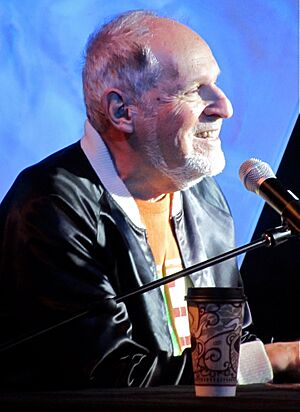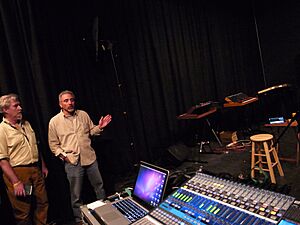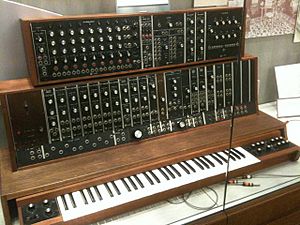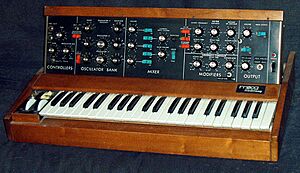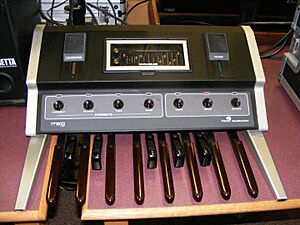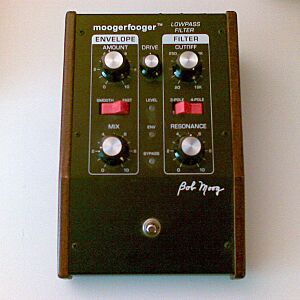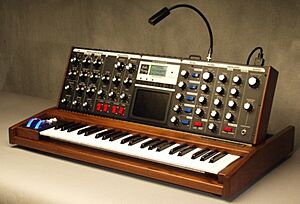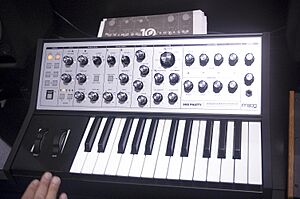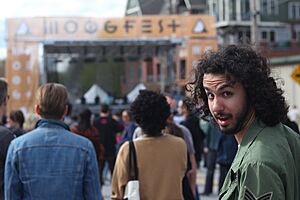Moog Music facts for kids
 |
|
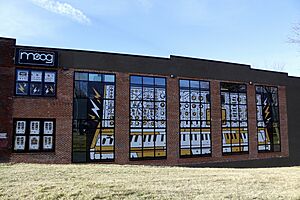
Exterior of Moog Music building in Asheville, North Carolina
|
|
|
Formerly
|
R. A. Moog Co. (1953-1972) |
|---|---|
| Subsidiary | |
| Founded | 1953 Trumansburg, New York, U.S. |
| Headquarters | Asheville, North Carolina, U.S. |
|
Key people
|
Robert Moog, founder Mike Adams, president |
| Products | Synthesizers, Musical instruments, Signal processing |
| Parent | inMusic |
Moog Music Inc. (/moʊɡ/ mohg) is an American company that makes cool electronic musical instruments called synthesizers. It's based in Asheville, North Carolina. The company was started in 1953 by Robert Moog and his father. Back then, it was called R. A. Moog Co., but it changed its name to Moog Music in 1972.
Some of their first instruments were the famous Moog synthesizer (which was the first commercial synthesizer ever!) and later the Minimoog in 1970. These instruments were super important in electronic music.
In 1973, Robert Moog sold Moog Music to another company, but he kept working there as a designer until 1977. Later, in 1978, he started a new company called Big Briar. Moog Music faced financial problems in 1987. The Moog Music name was returned to Robert Moog in 2002, and his company, Big Briar, started operating again as Moog Music. In June 2023, Moog Music became part of a larger company called inMusic.
Moog Music also used to help organize Moogfest, a special festival about electronic music and music technology.
Contents
- The Story of Moog Music
- Main Products
- Moog Synthesizer (1964)
- Minimoog (1970)
- Taurus (1975)
- Vocoder (1978)
- Moogerfooger (1998)
- Minimoog Voyager (2002)
- Little Phatty (2006)
- Sub Phatty (2013)
- Mother-32 (2015)
- DFAM (Drummer From Another Mother) (2018)
- Grandmother (2018)
- Matriarch (2019)
- Subharmonicon (2020)
- Mavis (2022)
- Spectravox (2024)
- Labyrinth (2024)
- Muse (2024)
- Moogfest
- List of Synthesizer Models
- External links
The Story of Moog Music
Early Days: Theremins and the First Synthesizer (1953–1971)
Robert Moog started his company, R. A. Moog Co., with his dad in 1953 when he was just 19 years old. They began by building and selling theremin kits and theremins. A theremin is a unique electronic instrument you play without touching it! They sold these through mail order from Robert's home. In 1963, the company opened its first real office in Trumansburg, New York.
In 1963, Moog met a composer named Herbert Deutsch. Deutsch had built a theremin using Moog's design. With ideas from Deutsch and other musicians, Moog created the Moog synthesizer. This was a groundbreaking instrument because it was the first voltage-controlled synthesizer that used a keyboard.
By 1967, R. A. Moog, Co. had grown. They still sold theremin kits, but their main focus was on selling the big modular Moog synthesizer systems. The sound of the Moog synthesizer became very popular, especially after Wendy Carlos released her famous album Switched-On Bach. However, the instrument was big, not easy to move, and expensive, so not everyone could buy one.
Changes and Challenges (1971–1977)
In November 1971, another company called muSonics bought R. A. Moog, Inc. The company moved to Williamsville, New York and was renamed Moog Musonics, and then Moog Music, Inc.
In 1972, a skilled salesman named David VanKouvering joined the company. He helped set up stores all over the world to sell Moog products. Even though the company became more successful with the new Minimoog synthesizer, they faced tough competition from other companies like ARP Instruments and Oberheim Electronics. This led to Moog Music, Inc. being sold to Norlin Industries in 1973. By 1975, ARP had a much bigger share of the synthesizer market, making it hard for Moog Music to compete.
In 1976, Norlin moved the company again. In 1977, Robert Moog's contract with Norlin ended, and he left to start his own new company, Big Briar.
New Products and Digital Changes (1978–1987)
After the Minimoog's success, Moog Music, Inc. released other products like the Vocoder, Micromoog, Multimoog, Polymoog, and Taurus bass pedals. Many artists used these, but none became as popular as the Minimoog. In 1978, another company, Sequential Circuits, released the Prophet-5, which became a new favorite in the industry.
Moog also faced strong competition from Japanese companies like Roland, Korg, and Yamaha. These companies made similar analog synthesizers that were just as good but cost less.
Around this time, digital synthesizers started to become popular. These were different from analog ones. In 1983, the MIDI interface was introduced, which allowed different musical instruments to talk to each other. This helped Yamaha release the DX7, the first very successful digital synthesizer. Moog Music tried to make digital synthesizers too, but they faced too many challenges and closed down in 1987.
Robert Moog's Return and Analog Comeback (2000–2005)
In the 1990s, people started to love the classic analog sound of Moog synthesizers again. Musicians like David Foster continued to use them, and old Minimoogs became valuable collector's items. In 2002, the Moog Music name was returned to Robert Moog after a legal process.
Moog Music moved to Asheville, North Carolina. They continued to make products that Robert Moog's earlier company, Big Briar, had created, like the Moogerfooger pedals and theremins. They also introduced new products such as the Minimoog Voyager, Little Phatty, Sub 37, and Mother 32. Many of these are still made and sold today. The company grew because many musicians became interested in analog synthesizers again.
After Robert Moog (2005–Present)
Robert Moog passed away in 2005. His friend and co-worker, Michael Adams, became the company's president. The company then started to be largely owned by its employees. In recent years, Moog Music has released many new products to meet what musicians want today. They have also made special limited editions of old, famous Moog synthesizers. They also started making instruments for the growing Eurorack synthesizer market, like semi-modular synthesizers such as the Mother 32, DFAM, Grandmother, Matriarch, and Subharmonicon.
In June 2023, Moog Music was bought by inMusic. Later that year, some staff at the Asheville office were laid off, and some parts of the company moved to a new building.
From 2011 to 2024, Moog sold its synthesizers at the Moog Store. The factory still makes instruments, and the Moogseum in Asheville continues to teach people about the company's history.
Main Products
Moog Synthesizer (1964)
Robert Moog invented the Moog synthesizer in 1964 after talking with composer Herbert Deutsch. This synthesizer was special because it used "modules." These were like independent electronic parts that did different jobs, such as making sounds (oscillators), shaping sounds (filters), or controlling how loud sounds were (amplifiers). Users could connect these modules in many ways to create amazing and complex sounds. It also had a keyboard, which made it familiar for musicians.
Moog showed the synthesizer at a conference in 1964, and it quickly became famous. Experimental artists and rock bands like the Byrds, the Beatles, the Rolling Stones, and the Doors started using it in their music.
The biggest success for the Moog synthesizer came in 1968 with Wendy Carlos's album Switched-On Bach. This album sold over a million copies and won three Grammy Awards!
Minimoog (1970)
The original Moog synthesizer was quite large, making it hard to use everywhere. So, Robert Moog, along with engineers Jim Scott and Bill Hemsath, built the Minimoog. The Minimoog was much smaller and simpler. It had the most important parts wired together, so you didn't need to connect them with cables.
The Minimoog also introduced the "pitch wheel." This allowed musicians to bend notes up or down, creating cool effects. Its small size and wide range of sounds made the Minimoog very popular, selling over 13,000 units. Famous artists like Yes, Pink Floyd, Stevie Wonder, Herbie Hancock, and Chick Corea quickly started using the Minimoog.
An updated version of the Minimoog was re-released in 2016.
Taurus (1975)
The Moog Taurus was the first Moog instrument specifically for bass sounds. It was an analog synthesizer played with foot pedals, like an organ. The first model had 13 pedals. Later, the Taurus II had 18 pedals, and the Taurus III went back to 13.
Many progressive rock bands used the Taurus, including Led Zeppelin, Rush, Yes, Genesis, and Dream Theater.
Vocoder (1978)
Moog Music released its commercial vocoder in 1978. A vocoder is an effect that can make voices sound robotic or like they are singing through an instrument. Many other companies already had their own vocoders. Because the Moog vocoder didn't easily connect with other digital instruments using MIDI, it wasn't as popular as some others.
Moogerfooger (1998)
The Moogerfooger was an analog effects pedal introduced under Robert Moog's company, Big Briar. These pedals allowed musicians to add special effects, like those from the original Moog synthesizer, to any sound. Effects included ring modulation (making metallic sounds) and low-pass filtration (making sounds darker). The Moogerfooger was successful, and many different models were made. It was stopped in 2018 after 20 years.
Minimoog Voyager (2002)
In 2002, after getting the Moog Music name back, the company started making the Minimoog Voyager. This was an updated version of the classic Minimoog. The Voyager kept the true analog sound path, but it added digital controls. This meant musicians could save their favorite sounds and use many other new features.
Little Phatty (2006)
The Little Phatty, released in 2006, was Moog Music's answer to people wanting a smaller, more affordable analog synthesizer. It was the last instrument that Robert Moog helped design. It was released shortly after he passed away in 2005.
Sub Phatty (2013)
In 2013, Moog Music released the Sub Phatty. This was the first synthesizer with a completely new electronic design since Robert Moog's death. It had a new oscillator design for an updated analog sound. Its popularity led to other versions like the Sub 37 and Subsequent 37. These newer models added more features, like a sequencer, and made it easier to change sounds directly from the front panel.
Mother-32 (2015)
With a new interest in modular synthesizers, Moog Music introduced the Mother-32 in 2015. This synthesizer works with the popular Eurorack standard and has the classic Moog sound. Since then, they have released more modules and semi-modular synthesizers.
DFAM (Drummer From Another Mother) (2018)
In 2017, Moog Music showed off the DFAM (Drummer From Another Mother). It's a percussive synthesizer that can make "dirty and punchy" drum sounds. It's also Eurorack-friendly, like the Mother-32.
Grandmother (2018)
Following the success of earlier modular synthesizers, Moog Music released the semi-modular Moog Grandmother synthesizer. This instrument gives musicians the freedom to connect different parts like a modular synth, but it's also easy to use like a regular synthesizer.
Matriarch (2019)
The Matriarch, released in 2019, is like a bigger version of the Grandmother. It has a wider keyboard, more modules, and an analog delay effect instead of a spring reverb.
Subharmonicon (2020)
The Subharmonicon is another Eurorack-compatible semi-modular synthesizer from Moog. It's designed to explore unique sounds based on subharmonics and polyrhythms.
Mavis (2022)
Mavis is a small, semi-modular synthesizer with a keyboard. It includes an envelope generator, LFO, wave folder, and filter bank, allowing for a variety of sounds.
Spectravox (2024)
The Spectravox is part of the "Mother" line of synthesizers. It has a special vocoder and filter bank, which can create drone sounds and colorful tonal sweeps.
Labyrinth (2024)
Also part of the "Mother" line, the Labyrinth features two generative sequencers, a wavefolder, and a state-variable filter. It's a Eurorack-compatible semi-modular tabletop synthesizer.
Muse (2024)
The Muse is an advanced analog machine that can play eight different sounds at once. It has multiple oscillators, filters, and effects, offering a rich sound.
Moogfest
Moogfest was a festival that started in New York City in 2004 to celebrate Robert Moog's work, electronic music, and technology. In 2010, the festival moved to Asheville, North Carolina, where Moog Music is located. Later, it moved to Durham, North Carolina, to focus more on technology and development.
The festival featured famous artists like Keith Emerson, Laurie Anderson, Brian Eno, and Jónsi from Sigur Rós. It also had workshops where people could learn about building instruments and music technology.
List of Synthesizer Models
- Moog modular synthesizer (1963–80, 2015–present)
- Minimoog (1970–81, 2016–2017, 2022–present)
- Moog Satellite (1974–79)
- Moog Sonic Six (1974–79)
- Minitmoog (1975–76)
- Micromoog (1975–79)
- Polymoog (1975–80)
- Moog Taurus (bass pedals) (1976–83)
- Multimoog (1978–81)
- Moog Prodigy (1979–84)
- Moog Liberation (1980–81)
- Moog Opus 3 (1980–83)
- Moog Concertmate MG-1 (1981–83)
- Moog Rogue (1981–83)
- Moog Source (1981–84)
- Memorymoog (1982–85)
- Moog SL-8 prototype (1983)
- Moogerfooger (1998–2018)
- Minimoog Voyager (2002–15)
- Moog Little Phatty (2006–13)
- Slim Phatty (2010–14)
- Taurus 3 bass pedal (2011)
- Minitaur (2012)
- Sub Phatty (2013)
- Sub 37 (2014)
- Moog Werkstatt-Ø1 (2014 kit, 2014 retail)
- Emerson Moog Modular (2014)
- Mother-32 (2015–present)
- Moog BFAM (Brother From Another Mother) (2016)
- Subsequent 37 CV (2017)
- Subsequent 37 (2017–present)
- Moog DFAM (Drummer From Another Mother) (2017 kit, 2018–present)
- Moog Subharmonicon (2018 kit, 2020–present)
- Moog Grandmother (2018–present)
- Moog One (2018–present)
- Sirin: Analog Messenger of Joy (2019–present)
- Moog Spectravox (2019)
- Moog Matriarch (2019–present)
- Moog Mavis (2022-present)
- Moog Labyrinth (2024)
- Moog Muse (2024)
External links
- The Moog Archives
- The Bob Moog Foundation
- Moog Guitar info
- NAMM Oral History Program Interview with Mike Adams (2010)
-
- Business data for Moog Music, Inc.: Google Finance
- Yahoo! Finance
- Hoover's
ja:モーグ・シンセサイザー



